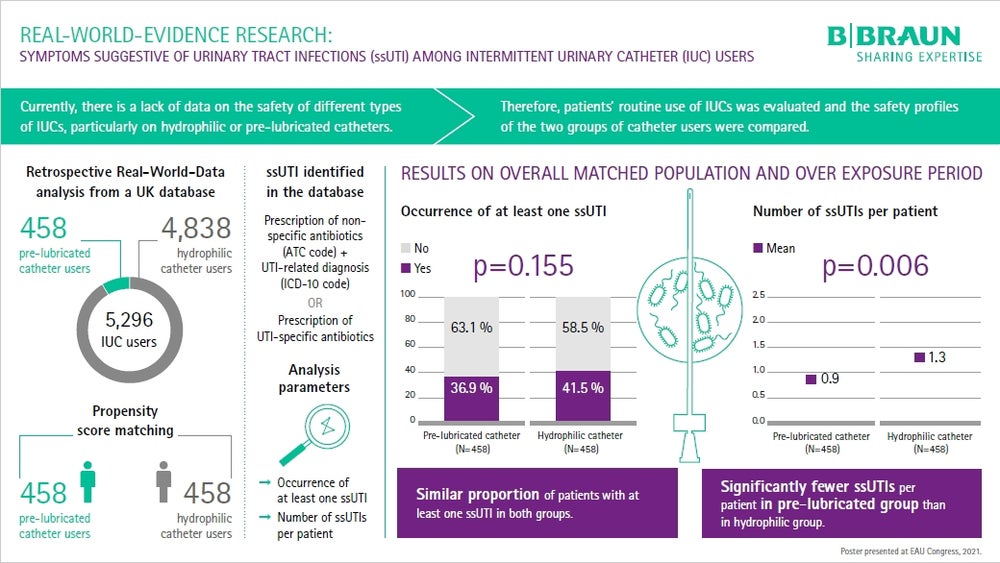Urinary tract infection - a common burden
Urinary tract infections (UTIs) remain a recurrent complication of intermittent catheterization which has a significant impact on the patients’ overall health and quality of life.1,2,3,4 The emotional and practical burden of intermittent catheterization and UTIs is considerable in the patients’ lives.3 Patients with spinal cord injuries who practice intermittent catheterization spend 23 to 63 percent of their lifetime with urinary tract infections.5 Symptomatic UTIs have a negative impact on the patients’ long-term compliance to intermittent catheterization and makes their organisms resistant.6,7 Research in this topic is therefore of upmost importance as very few studies have been done in the past.
UTIs have negative consequences for both the patient and the facility:8
- Longer hospital stays due to illness or complications during therapy8
- Economic burden for the healthcare system5
- UTIs increase costs because, at least in part, more costly alternatives to antimicrobial therapies and infection control measures are needed.9
Recurrent urinary tract infections often lead to repeated use of antibiotics and thus to the development of antibiotic resistance. It is therefore very important to reduce the risks of UTIs in patients as much as possible.
Real-World Evidence
Research into ssUTIs in users of intermittent urinary catheters
We conducted the first Real-World Evidence of intermittent catheterization to compare the effects of pre-lubricated and hydrophilic catheters on the incidence of symptoms suggestive of urinary tract infections (ssUTIs). This research was based on a patient database in the UK.
A patient database compiled by a representative panel of 1,950 general practitioners in the UK was used for this longitudinal, observational study. This database considers 5,296 people using catheters.
Outcome of the study
Most importantly, the study showed significant results indicating a lower incidence of ssUTIs when pre-lubricated catheters were used:
- The number of patients with at least one ssUTI was significantly lower in the pre-lubricated catheter users’ group compared to the hydrophilic catheter users’ group (p=0.015).
- Over the exposure period, there were significantly fewer ssUTIs per patient in the pre-lubricated group than in the hydrophilic group (p=0.006), particularly in the pre-lubricated female group (p=0.010) and in the subgroup of [18-50[ years (p=0.021).
- For patients with at least one UTI over the exposure period, pre-lubricated cohorts maintained their comparative advantage versus to hydrophilic cohorts (p=0.013).
Download
What is Real-World Evidence (RWE) and Real-World Data (RWD)?
Real-World Evidence (RWE) and randomized control trial (RCT) data are considered mutually complementary and a most powerful resource in evidence-based medicine.1 |
Professor Chapple (Royal Hallamshire Hospital, Department of Urology, Sheffield, United Kingdom), Professor Chartier Kastler (Sorbonne University, Department of Urology, Paris, France) and Professor Schurch (Vaudois University Hospital of Lausanne, Department of Clinical Neurosciences, Lausanne, Switzerland) participated in and supported this study which was accepted by three different congresses:
- European Association of Urology (EAU) 8 -12 July 2021
Author: Prof. Emmanuel Chartier-Kastler - ISCoS, Canada, Vancouver, 29 Sept -2 Oct 2021
Author: Prof. Emmanuel Chartier-Kastler - ICS, Australia, Melbourne, 14 -17 Oct 2021
Author: Prof. Emmanuel Chartier-Kastler
Speaker: Prof. Chapple
References
1. Hun-Sung K et al. J Korean Med Sci. 2018; 33(34):e213.
2. Bonkat G, Bartoletti R, Bruyère F, Cai T, Geerlings SE, Köves B, Schubert S, Wagenlehner F. EAU Guidelines on Urological Infection. Edn. presented at the EAU Annual Congress Milan 2021. ISBN 978-94-92671-13-4.https://uroweb.org/guideline/urological-infections/
3. Pickard R et al. Continuous low-dose antibiotic prophylaxis to prevent urinary tract infection in adults who perform clean intermittent self-catheterisation: the AnTIC RCT. Health Technol Assess. 2018; 22(24):1-102. doi: 10.3310/hta22240
4. Wyndaele JJ. Complications of intermittent catheterization: their prevention and treatment. Spinal Cord. 2002; 40(10):536-41. doi: 10.1038/sj.sc.3101348
5. Rognoni C, Tarricone R. Healthcare resource consumption for intermittent urinary catheterisation: cost-effectiveness of hydrophilic catheters and budget impact analyses. BMJ Open 2017; 7:e012360. doi: 10.1136/bmjopen-2016-012360
6. Afsar SI, Yemisci OU, Cosar SNS, Cetin N. Compliance with clean intermittent catheterization in spinal cord injury patients: a long-term follow-up study. Spinal Cord. 2013; 51(8):645-9. doi: 10.1038/sc.2013.46
7. Flores-Mireles AL, Walker JN, Caparon M, Hultgren SJ. Urinary tract infections: epidemiology, mechanisms of infection and treatment options Nature Reviews Microbiology. 2015; 13:269-284 (2015).
8. Holmberg SD, Solomon SL, Blake PA. Health and economic impacts of antimicrobial resistance. Reviews of Infectious Diseases. 1987; 9:1065-1078. doi: 10.1093/clinids/9.6.1065
9. Knobler SL, Lemon SM, Najafi M, Burroughs T. Resistance Phenomenon in Microbes and Infectious Disease Vectors: Implications for Human Health and Strategies for Containment. Institute of Medicine (US) Forum on Emerging Infections. 2003. doi: 10.17226/10651

